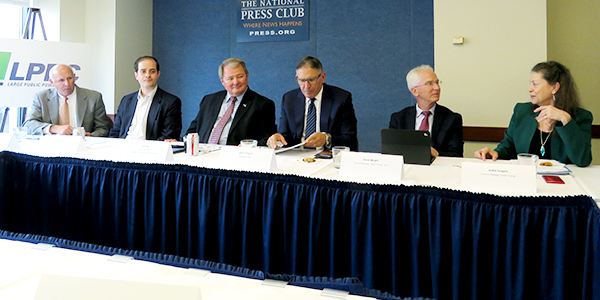By Rich Heidorn Jr.
WASHINGTON — Senior executives of some the nation’s largest public power utilities came to D.C. this week to lobby Congress on tax policy and talk to the executive branch about federal reviews of infrastructure projects. They also squeezed in meetings with FERC.
One issue that was not top of mind was the Trump Administration’s announcement last week it was replacing the Clean Power Plan with less stringent emission rules for coal-fired generation.
So does the Affordable Clean Energy rule matter in the utilities’ long-term plans?
“No,” said Thomas Falcone, CEO of the Long Island Power Authority, during a press briefing with other executives in the delegation from the 27-member Large Public Power Council. “New York [last week] passed its own climate bill in the absence of federal energy policy. That climate bill seeks to have a carbon-neutral economy by 2050 and carbon-free grid by 2040. In New York, we have one coal plant … it’s supposed to shut down by 2020.”
Executives from public power companies in Texas, Washington, Nebraska and North Carolina agreed: Current federal policy is far less important to their decision-making than their states’ rules.
“I don’t spend a lot of time worrying about the ACE rule,” said Pat Pope, CEO of the Nebraska Public Power District.
No Lifeline for Coal
The ACE rule defines the best system of emissions reductions (BSER) as heat-rate efficiency improvements that can be achieved at individual coal plants, not the “beyond the fence line” generation-shifting, fuel-switching and state emission caps required under the CPP. (See EPA Finalizes CPP Replacement.)
Although some praised the policy as a rejection of the Obama administration’s “war on coal,” the ACE rule won’t be a lifeline for coal plants in North Carolina or Nebraska, officials said.
“We’re certainly moving ahead with ways to mitigate our carbon footprint,” said Pope, who noted NPPD is converting one of its smaller coal plants to burn hydrogen.
It’s also planning to offset greenhouse gas emissions by capturing methane from the state’s agriculture industry. “We’re actively exploring ways we can stop those emissions from occurring and credit that toward our coal emissions, and [we’re] still looking at carbon capture and sequestration,” Pope said. “We’re situated in an area where there’s probably more opportunities for sequestration than in other areas of the country. We’re going to take a hard look at that.”
Heat Rate Improvements Elusive

Roy Jones, CEO of ElectriCities of North Carolina, said his company is also phasing out coal. “When I look at the ACE plan, the heat rate improvements in the plan — if they were economical, they’d have already been done,” Jones said.
Pope agreed. “The way we operate, we’re always going after these efficiency improvements. We’re all about lowering the cost to our consumers, running very efficient plants and operations. So the low-hanging fruit of those types of projects is long gone. … I think the incremental opportunities for others [are] going to be pretty small.”
Public power owns no coal in Washington state, said Steve Wright, general manager of the Chelan County PUD. Last month, Gov. Jay Inslee, who has made climate change the centerpiece of his longshot presidential campaign, signed the Clean Electricity Transformation Act, which bans utilities’ use of coal by 2025 and sets a 2045 target for emission-free power.
“The decision [away from fossil fuels] has already been made,” Wright said. “Now we’re trying to figure out how we’re going to make it work.”
Reinvesting in Hydropower
In Washington, that means a continued dependence on hydropower, which supplies 70% of the state’s electricity.
“It’s an aging hydropower system,” Wright said. “The challenge is how are we going to maintain that capability because as you add variable energy — non dispatchable resources — you need something to maintain reliability.
“It’s going to take a very large reinvestment in the system in order for it to be maintained because most of it was built as late as the 1970s, so the youngest plants are 40 years old. There’s a lot of work to do there, but with the right investments, we can make it work.”
‘Holistic’ View
With no stockholders, “having [our] finger on the pulse of community is very important,” said North Carolina’s Jones. “And as we talk to our community about climate change, without exception every one of them has individuals in the community that want to do more with renewables. Rooftop solar, community solar. Things they can do to make their homes more energy efficient and reduce their carbon footprint.”
Jones said North Carolina is almost a quarter of the way towards its goal of a 40% reduction in carbon emissions from 2005 levels by 2040.
To close the gap, Jones said the company is discussing ways to electrify the transportation system. “When we step back and look at the carbon footprint, we’re not just looking at the electric industry. We’re looking holistically in our communities. What are things we can do to reduce that carbon footprint.”
Austin Energy, which has been transitioning to renewable energy and emphasizing energy efficiency and demand-side management, will shut its last two large gas-fired steam units by 2021 and plans to exit from its coal position by 2022, said General Manager Jackie Sargent.
Because of ERCOT’s “robust” market and great transmission access, Sargent said the utility has been able to add wind and solar resources with locational diversity. “So, I don’t see the ACE rule impacting us in a significant way,” she said.








